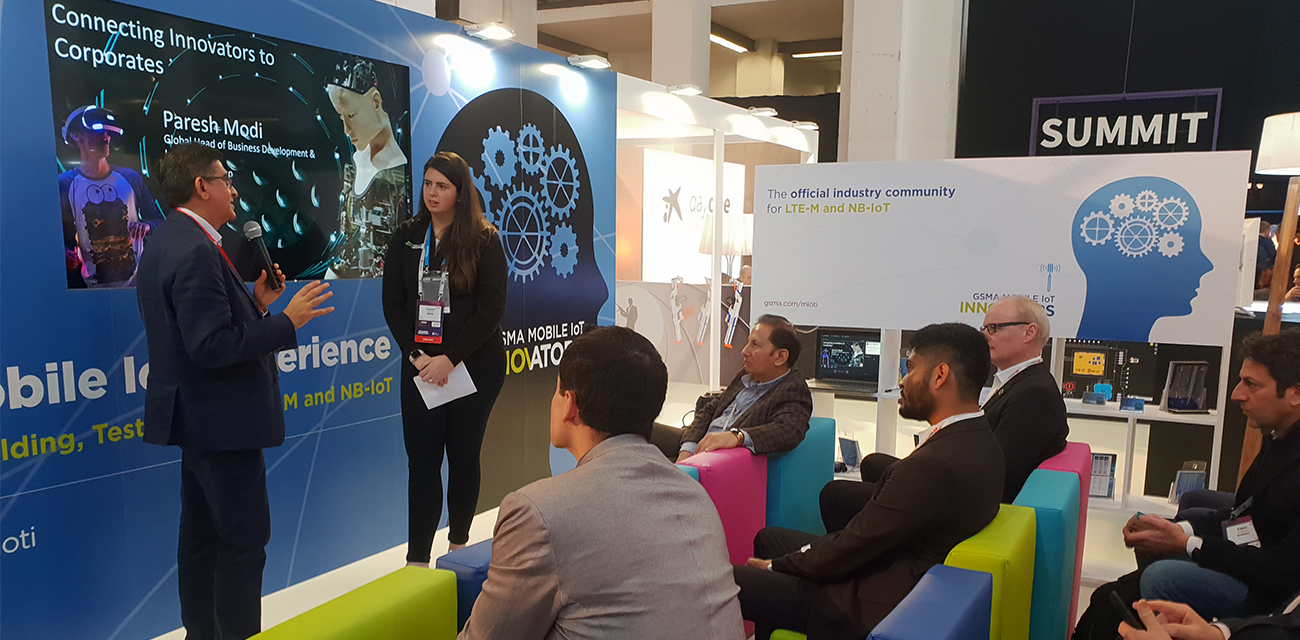MWC Barcelona 2019 showcases new tools to streamline the development of Mobile IoT applications
Creating compelling Mobile IoT applications is becoming increasingly straightforward. As part of the Mobile IoT Experience at MWC19 Barcelona, a clutch of companies were demonstrating new tools to help developers employ the reliable and secure low power wide area connectivity provided by Mobile IoT technologies – LTE-M and NB-IoT.
Visitors to the GSMA Mobile IoT Experience in the 4YFN exhibition, which is aimed at developers, start-ups, entrepreneurs and investors, could talk to experts from Arduino, Huawei and mangOH/Sierra Wireless about how to rapidly prototype Mobile IoT applications using the companies’ latest developer kits.
The experts were struck by the high level of engagement among the developers attending the show. “We definitely saw a lot of interest from developers in NB-IoT and LTE-M, and for an open source industrial-grade developer kit and ecosystem,” notes Thibault Cantegrel, Director of the Developer Program at Sierra Wireless, which was demonstrating its mangOH Yellow open source hardware for industrial-grade Mobile IoT applications. In a “world first demo”, Sierra Wireless showed how mangOH Yellow can enable two devices to efficiently communicate with each other via the cloud and Mobile IoT connectivity. Thibault Cantegrel says mangOH has already attracted a substantial developer community and an ecosystem of partners, including specialists in Mobile IoT technologies and other areas needed to build, deploy and maintain a reliable solution.
Tracking and monitoring all kinds of assets
Visitors to the Mobile IoT Experience were seeking to apply low power wide area connectivity in many different sectors of the economy, says Thibault Cantegrel, adding: “The most common was maybe fixed asset monitoring. Second was maybe mobile asset tracking and monitoring.”
As they can provide inexpensive, reliable and secure connectivity in licensed spectrum, Mobile IoT technologies are well-placed to help organisations monitor a diverse range of mobile and fixed assets, including everything from shipping containers and irrigation systems to street lamps and recycling facilities. At MWC19 Barcelona, there was a lot of interest in using Mobile IoT technologies to underpin smart city and smart metering solutions, according to Martino Facchin, Senior Firmware Engineer at Arduino. He showed visitors how Arduino’s tools could be used to create LTE-M or NB-IoT applications “in minutes” and how to secure, monitor and analyse the data being generated by these applications. Martino Facchin encourages developers to experiment, noting “the best way to understand IoT is to do it. From an Arduino point of view, there should be no entry barrier to start developing with these technologies.”
Several demos at the Mobile IoT Experience highlighted the versatility of LTE-M and NB-IoT. For example, visitors could see how the Altair Smart Flow solution can track real-time consumption of beer, as well as the fill level and location of kegs in the supply chain. That information can help prevent fraud, detect anomalies and improve quality control, as well as enable predictive maintenance. The Smart Flow solution can also help the beverage industry understand consumer behaviour and brand favourites across bars, regions and time of day and week. Meanwhile, Igloohome showcased an NB-IoT-connected smart door lock that enables secure access to infrastructure assets and properties, with the ability to remotely control access to a site by time and person. Igloohome says the solution can drive significant operational efficiency improvements for companies managing a portfolio of sites and properties, while eliminating the hassle associated with managing, distributing and losing physical keys. As the smart lock connects directly to the NB-IoT network, there is no need for a separate hardware hub.
Raising awareness and driving adoption
Both Martino Facchin and Thibault Cantegrel gave “lighting talks” in the Training Zone of the Mobile IoT Experience, which hosted an intensive programme of presentations covering a variety of Mobile IoT and IoT security topics. As part of that programme, Lorenzo Viola, Senior Engineer at Huawei’s Testing and Reliability Engineering Centre, and Zaheen Khan, Head of Wireless Marketing and Strategy at Huawei, outlined how to use the company’s end-to-end IoT development solutions and IoT hosting centre. Engaging with both developer pros and experimenting hobbyists, Huawei’s experts also provided visitors to the Mobile IoT Experience with advice on how to build their first IoT project, downtime for rapid prototyping, simplifying the integration process, reducing time to market and integrating with third-party application programming interfaces (APIs).
For Arduino, 4YFN provided a valuable opportunity to raise awareness of its MKR family of developer boards, which are differentiated by their support for transparent security and the ability to easily swap radio technologies in and out, according to Martino Facchin. He says developers are very interested in adopting LTE-M and NB-IoT, noting the maturity of LTE-M in North America, Martino Facchin believes mobile operators in Europe need to work together to facilitate Mobile IoT roaming across the region.
Fitting into the 5G picture
Thibault Cantegrel at Sierra Wireless also stresses that network coverage will play a major role in determining the speed of adoption of Mobile IoT technologies, which are being integrated into mobile operators’ 5G development and deployment plans. “NB-IoT and LTE-M are part of 5G, which seems understood at least by those people who asked” at MWC19, explains Thibault Cantegrel. “There is no sign that people would wait for 5G. Instead they are eager to test NB-IoT and LTE-M.”
While the MWC19 show floor buzzed with the debut of 5G smartphones and immersive entertainment apps, the next generation of mobile technologies will also support a very wide range of IoT applications, including everything from live video footage captured by security cameras to dense deployments of sensors monitoring environmental conditions. For applications that don’t require high throughput or very responsive connectivity, Mobile IoT networks are likely to be the default choice in the 5G era. “Bandwidth and low latency are not going to be interesting for the embedded market unless there’s a real use case for that,” notes Martino Facchin of Arduino. He says one such use case “could have been rich artificial intelligence (AI) applications running in datacentres, but the tech world is moving towards AI at the edge, so bandwidth is not going to be a problem.” Where that is the case, a secure, low cost Mobile IoT network may be the connectivity of choice.

